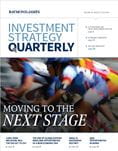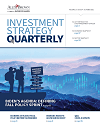Risks and opportunities of a new economic era
Ed Mills, Managing Director, Washington Policy, discusses how recent U.S. policy decisions are the foundation for an industrial renaissance aimed at building up the economic base and protecting it against certain geopolitical and supply chain risks.
To read the full article, see the Investment Strategy Quarterly publication linked below.
Are the U.S. and Chinese economies decoupling, or are we seeing a more strategic approach to national security priorities and supply chain resiliency? The answer to this question depends upon the policy decisions over the next several years and could have massive implications for the global economy and equity market. We are of the view that a broad-scale decoupling and the formation of regional economic blocs is less likely, but a trend of reindustrialization and de-risking will be a market theme that investors will navigate in the years ahead.
U.S. and China at a crossroads: A shift in the global economic order
Concern over China’s longer-term geopolitical ambitions and the threat posed by China’s military to the U.S. and key allies has been a major focus of U.S. policy in recent years. During the Trump Administration, concerns about China’s unequal market access and intellectual property theft led to the 2018 “trade war” with tariffs levied against a broad set of China’s imports into the United States. A key concern was that U.S. technology designed for civilian use could be repurposed for military application. This led to U.S. policy viewing technology as a national security asset, thereby implementing new export restrictions and blacklisting various Chinese companies from receiving access to U.S. technology, especially in the semiconductor space. The flow of U.S. capital into critical sectors in China that finance China’s economic competition with the U.S. also came under enhanced scrutiny. While this economic confrontation was initially driven by national security considerations, the COVID-19 pandemic exposed additional vulnerabilities around global supply chains, particularly with technology components and medical goods that drove shortages and spiked prices. These conditions set the stage for a rethinking of U.S.-China economic relations that quickly became a bipartisan consensus in Washington.
Government response: Securing supply chains and investing in the domestic industrial base
In response to the dynamics, the U.S. government has enacted policies with both “sticks” and “carrots” that create challenges and opportunities for investors navigating the shifting global environment. Export controls, tariffs, and economic restrictions through the blacklisting of certain companies have created revenue and cost challenges for U.S. companies with significant exposure to China’s market. Frequently, these policies are announced with little warning and carry high impact – raising headline risk for exposed sectors. However, policymakers have also unleashed more than $1 trillion in domestic investment across pandemic relief measures and new funding for domestic infrastructure, semiconductor manufacturing, and the energy transition. Key legislation on this front includes the 2021 American Rescue Plan ($350 billion in funding for infrastructure), the 2021 Infrastructure, Investment, and Jobs Act ($550 billion), the 2022 CHIPS and Science Act ($52.7 billion), and the 2022 Inflation Reduction Act ($392 billion). These new policies direct federal funds and catalyze private sector investment toward what we refer to as the ‘reindustrialization’ of North America. Even with this level of new investment, we still see significant appetite in Washington to build on and supercharge certain aspects of the domestic economic agenda.
What's next
Investors should be aware of critical trends that will impact the evolution of this emerging theme. First, China’s response can increase market risks if U.S. policy actions are seen less as "de-risking" and more as "decoupling" by another name. U.S. companies could be targeted as retaliatory steps, which can raise overall U.S.-China tensions. The fate of Taiwan and the outcome of its presidential elections in January 2024 will also be important to monitor. While the Biden administration is taking steps to de-escalate tensions around the question of Taiwan’s status, China perceiving Taiwan as moving closer to independence could accelerate the timeline for a regional conflict that could drive global economic disruption on a significant scale. Lastly, the inflationary impact of a shifting global economic order will have important consequences for the direction of monetary policy. Higher costs and elevated spending could weaken the Federal Reserve’s tools to fight inflation and prolong high interest rates – a "higher for longer" scenario. We expect attention to increase on these issues over the next year, especially as the U.S. prepares for the 2024 presidential election campaign that will help determine the trajectory of a changing macro investment environment.

Read the full
Investment Strategy Quarterly
All expressions of opinion reflect the judgment of the Chief Investment Office, and are subject to change. This information should not be construed as a recommendation. The foregoing content is subject to change at any time without notice. Content provided herein is for informational purposes only. There is no guarantee that these statements, opinions or forecasts provided herein will prove to be correct. Past performance may not be indicative of future results. Asset allocation and diversification do not guarantee a profit nor protect against loss. The S&P 500 is an unmanaged index of 500 widely held stocks that is generally considered representative of the U.S. stock market. Keep in mind that individuals cannot invest directly in any index, and index performance does not include transaction costs or other fees, which will affect actual investment performance. Individual investor’s results will vary. Investing in small cap stocks generally involves greater risks, and therefore, may not be appropriate for every investor. International investing involves special risks, including currency fluctuations, differing financial accounting standards, and possible political and economic volatility. Investing in emerging markets can be riskier than investing in well-established foreign markets. Investing in the energy sector involves special risks, including the potential adverse effects of state and federal regulation and may not be suitable for all investors. There is an inverse relationship between interest rate movements and fixed income prices. Generally, when interest rates rise, fixed income prices fall and when interest rates fall, fixed income prices rise. If bonds are sold prior to maturity, the proceeds may be more or less than original cost. A credit rating of a security is not a recommendation to buy, sell or hold securities and may be subject to review, revisions, suspension, reduction or withdrawal at any time by the assigning rating agency. Investing in REITs can be subject to declines in the value of real estate. Economic conditions, property taxes, tax laws and interest rates all present potential risks to real estate investments. The companies engaged in business related to a specific sector are subject to fierce competition and their products and services may be subject to rapid obsolescence.

